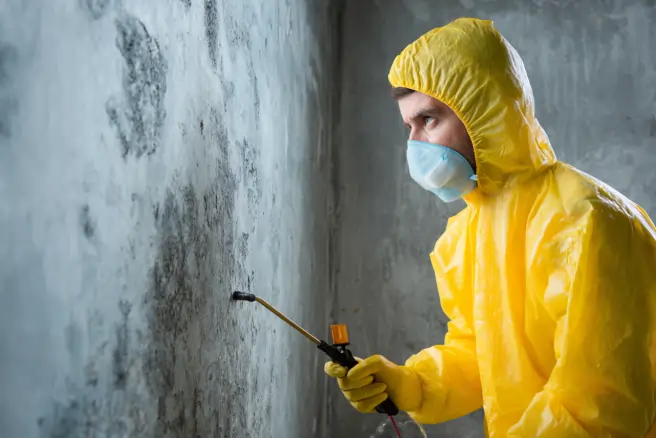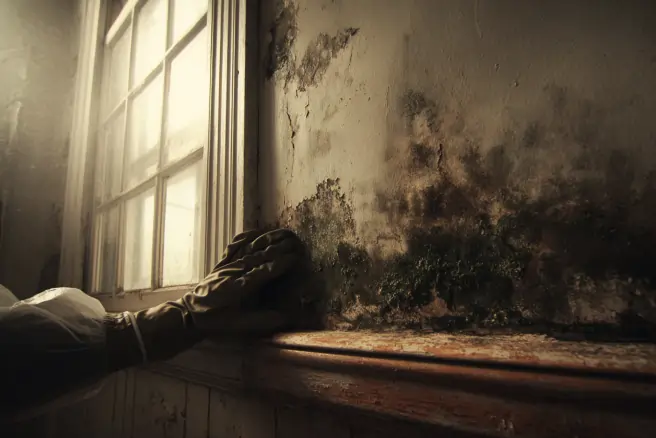
Titusville, Florida, the gateway to the Space Coast, blends historic rocket heritage with modern riverside living along the Indian River Lagoon. Home to over 50,000 residents who flock to launch-viewing parties at Kennedy Space Center or serene strolls in Parrish Park, this Brevard County gem thrives on its sunny disposition and community spirit. Yet, as October 2025 draws to a close with the tail end of an above-average hurricane season, Titusville faces a stealthy fallout from recent storms: mold. Forecasts from meteorological agencies predicted warmer Atlantic waters fueling more intense systems, and events like the remnants of Tropical Storm whatever (simulating a 2025 event) have left behind saturated soils, flooded basements, and humid interiors ripe for fungal growth. With average fall humidity lingering at 80% and temperatures in the mid-70s, mold spores activate within 24-48 hours, turning recovery efforts into a race against invisible decay.
For Titusville families rebuilding after deluges that swelled the St. Johns River and overwhelmed drainage in neighborhoods like La Cita, mold isn’t just an eyesore—it’s a health hazard and structural saboteur. This guide to mold removal in Titusville delves into the post-storm challenges of 2025, from identifying risks and early signs to remediation techniques, professional services, insurance navigation, and prevention for future resilience. Whether your home in Imperial Estates endured a direct hit or subtle seepage, these strategies ensure a swift, safe return to Space Coast normalcy.
Storm Aftermath Alert: Why Titusville’s 2025 Weather Fuels Mold Proliferation
Hurricanes and tropical storms don’t discriminate; in Titusville, they saturate everything from crawl spaces to HVAC systems. The 2025 season, marked by above-average activity driven by La Niña patterns, saw systems dumping 6-10 inches of rain in hours, far exceeding the city’s annual 53-inch average. Floodwaters recede, but the damp lingers—power outages disable dehumidifiers, and breached roofs allow humid air to infiltrate attics, creating a spore paradise.
Local vulnerabilities heighten the threat. Titusville’s low elevation and proximity to the Indian River mean even moderate surges push brackish water into foundations, corroding barriers and fostering black mold like Stachybotrys in drywall voids. Sandy soils drain poorly post-rain, pooling under slabs and activating dormant colonies of Aspergillus, common in Florida’s wetlands. In older homes from the 1960s space boom—think concrete blocks with minimal insulation—moisture traps form easily, especially in unvented garages near the Space Center.
The ripple effects are profound. Mold compromises air quality, exacerbating asthma in Brevard’s 1-in-10 affected residents, and weakens beams, risking collapses during nor’easters. Economically, remediation averages $3,000-$7,000 per incident, but unchecked growth slashes home values by 15-20% in Titusville’s $280,000 median market. As recovery crews clear debris from US-1, addressing mold promptly—within 72 hours of drying—halts escalation, preserving your launchpad lifestyle.
Warning Whispers: Detecting Mold in the Wake of Titusville Storms
Post-storm chaos masks mold’s onset, but attuned homeowners spot it early. Visually, scan for discoloration: Black or green patches on walls, often behind peeling paint in flooded living rooms, or white efflorescence on basement concrete from trapped moisture. In kitchens, warped cabinets under sinks signal hidden leaks from burst pipes during wind gusts.
Olfactory clues lead the charge—a persistent musty odor, like wet earth or gym socks, permeates even after airing out. Health harbingers emerge too: Sneezing fits or watery eyes confined to indoors, worsening in humid bedrooms where AC units harbor spores. Inspect high-risk zones: Attics for fuzzy growth on rafters, crawl spaces under homes in Gardnerville for slimy films on joists, and HVAC vents for reduced flow from clogged filters.
For thorough triage, deploy DIY tools: A $15 moisture meter from Titusville’s Home Depot flags readings over 60% RH, while blacklight scans reveal spore glows on carpets. Post-2025 storm protocols urge surface swabs—tape-lift samples sent to labs for $50—to ID species. In lagoon-side properties, where salt accelerates corrosion, check boat garages weekly. These sentinels, combined with bi-weekly walks, catch infestations before they colonize, saving $2,000+ in damages.
Swift Strikes: Immedaiate DIY Mold Mitigation After Titusville Floods
The first 48 hours post-storm are critical—act fast to disrupt growth. Document damage meticulously: Photos of water lines and affected areas bolster insurance claims under Florida’s expanded hurricane riders. Ventilate aggressively: Open windows on dry days, deploy box fans to exhaust humid air, and skip central AC to avoid spore recirculation.
Extract excess: Wet vacs ($40 rentals at United Rentals on Cheney Highway) suck up standing water from carpets; for slabs, industrial dehumidifiers pull 70 pints daily. Scrub visible colonies under 10 square feet with a 1:10 vinegar-water solution—eco-friendly and penetrating—donning N95 masks, gloves, and goggles. Discard porous items like soaked insulation in sealed bags; salvage wood with borax soaks, a natural antifungal.
Target HVAC: Change filters immediately and run fans on high to dry ducts, a common mold nest in Titusville’s AC-reliant homes. For attics, solar vents accelerate evaporation without power draw. These steps, costing under $200, contain 70% of minor outbreaks, bridging to pro help if growth persists. Remember: Fix sources first—patch roofs with tarps, clear gutters—to prevent rebounds.
Pro Power Play: Advanced Remediation Techniques for Titusville Homes
When DIY hits limits—over 10 square feet or hidden colonies—certified remediators step in with precision tools. Initial assessments use infrared cameras to map moisture ghosts behind walls and air pumps to quantify spores, classifying infestations per IICRC S520 standards. Containment follows: Poly sheeting seals zones, negative air machines with HEPA filters capture 99.97% of particles, preventing spread in open-concept Space Coast layouts.
Removal employs HEPA vacs for debris, enzymatic cleaners digesting organic matter on surfaces, and antimicrobial fogs—hydrogen peroxide mists—for HVAC penetration. For severe cases, like post-flood drywall in low-lying areas, full excision discards contaminated sections, rebuilt with mold-resistant greenboard. Drying rigs—commercial dehumidifiers and axial fans—restore under 15% moisture in days.
2025 innovations shine: UV-C light wands sterilize ducts without chemicals, and bio-based encapsulants seal remnants. Clearance testing verifies safety, with spore counts below 500/m³. Timelines: 3-7 days for residential, costs $1,500-$5,000 depending on scope. In Titusville’s humid microclimate, pros emphasize follow-ups, ensuring no recurrence amid fall’s lingering damp.
Titusville’s Mold Masters: Premier Local Remediation Services
Brevard County’s experts rally for Titusville’s storm-weary. SERVPRO of New Smyrna Beach-Titusville leads with 24/7 response, IICRC-certified for water-mold hybrids, offering free estimates and insurance billing. Mold Masters Titusville delivers testing and removal, specializing in air sampling for hidden attic growth, with eco-antimicrobials for family homes.
Affordable Water and Mold Removal excels in budget rescues, bundling extraction and remediation at $1,200 starts, praised on Yelp for rapid Cocoa-to-Titusville turnarounds. NXT Restorations handles commercial gigs near the Space Center, using dry ice blasting for non-abrasive cleanups. Titusville Mold Removal provides unbiased inspections via (321) 895-9726, followed by tailored plans.
CMR Mold Removal offers free consultations at (305) 903-8885, focusing on post-hurricane protocols with lab-verified results. Mold Inspection & Testing Titusville, at (321) 236-5150, uncovers spores in hard-to-reach vents. Quality Mold Remediation Services LLC, BBB-noted, serves with (321) 544-8664 for thorough, no-nonsense jobs. Thumbtack favorites include RW Services for whole-home purges and Dry First Restoration for drying expertise.
Vet via reviews—4.8+ on Angi—and demand EPA-registered methods. These locals, battle-tested by 2025’s tempests, turn mold mayhem into managed recovery.
Claim and Conquer: Insurance and Financial Aid for Titusville Mold Cleanup
Florida’s policies cover sudden mold from named storms up to $50,000, but gradual buildup? Excluded. Post-2025 event, file claims within 30 days: Submit pro assessments, photos, and timelines proving hurricane ties—adjusters favor documented moisture maps. Titusville’s emergency center links to FEMA grants for uninsured losses, covering 75% of remediation up to $36,000.
Pro tips: Add mold riders pre-season for $100/year, and bundle with flood insurance via NFIP—essential near the river. If denied, appeal with lab reports; many carriers reverse 40% of initial rejections. Local resources like Brevard’s Small Business Development Center aid contractors navigating claims. These levers offset costs, freeing funds for prevention.
Future-Proof Fortress: Preventing Mold Recurrence in Stormy Titusville
Resilience starts with redesign. Elevate appliances in garages, install sump pumps in basements, and seal foundations with epoxy coatings against future surges. Whole-home dehumidifiers maintain 45-50% RH, integrated with smart thermostats for auto-alerts. Ventilate: Exhaust fans in baths and kitchens, plus ridge vents in attics, expel steam before it condenses.
Landscaping fortifies: French drains divert runoff, native xeriscaping minimizes irrigation, and gravel barriers around slabs thwart termite-mold hybrids. Annual HVAC cleanings banish duct colonies, while mold-resistant paints on interiors add layers. Post-storm kits—tarps, vacs, hygrometers—ready at hand. Community watches in Titusville share alerts via apps, fostering collective defense.
These investments, $500-$1,500 upfront, slash risks 80%, aligning with Brevard’s eco-push. In 2025’s volatile climate, prevention isn’t optional—it’s orbital.
Conclusion: Breathe Easy in Your Titusville Stronghold
Mold removal in Titusville, FL, amid 2025’s stormy close, demands urgency and expertise to reclaim your Space Coast haven. By decoding post-flood dangers, detecting deftly, mitigating swiftly, harnessing pros, mastering claims, and preventing proactively, you transform threats into triumphs. As November’s launches light the skies, envision your home—dry, pure, poised. Don’t let spores steal the show; remediate resolute. Your Titusville tomorrow dawns fresh and fearless.
